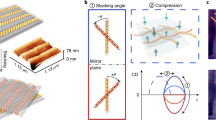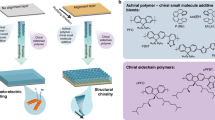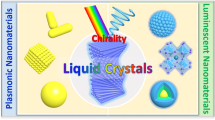Abstract
Nanostructures with chiral geometries exhibit strong polarization rotation. However, achieving reversible modulation of chirality and polarization rotation in device-friendly solid-state films is difficult for rigid materials. Here, we describe nanocomposites, made by conformally coating twisted elastic substrates with films assembled layer-by-layer from plasmonic nanocolloids, whose nanoscale geometry and rotatory optical activity can be reversibly reconfigured and cyclically modulated by macroscale stretching, with up to tenfold concomitant increases in ellipticity. We show that the chiroptical activity at 660 nm of gold nanoparticle composites is associated with circular extinction from linear effects. The polarization rotation at 550 nm originates from the chirality of nanoparticle chains with an S-like shape that exhibit a non-planar buckled geometry, with the handedness of the substrate’s macroscale twist determining the handedness of the S-like chains. Chiroptical effects at the nexus of mechanics, excitonics and plasmonics open new operational principles for optical and optoelectronic devices from nanoparticles, carbon nanotubes and other nanoscale components.
This is a preview of subscription content, access via your institution
Access options
Subscribe to this journal
Receive 12 print issues and online access
$259.00 per year
only $21.58 per issue
Buy this article
- Purchase on Springer Link
- Instant access to full article PDF
Prices may be subject to local taxes which are calculated during checkout





Similar content being viewed by others
References
Pasteur, L. Mémoire sur la relation qui peut exister entre la forme cristalline et la composition chimique, et sur la cause de la polarisation rotatoire. C. R. Acad. Sci. Paris 26, 535–538 (1848).
Chen, W. et al. Nanoparticle superstructures made by polymerase chain reaction: collective interactions of nanoparticles and a new principle for chiral materials. Nano Lett. 9, 2153–2159 (2009).
Peng, X. et al. Optically active single-walled carbon nanotubes. Nature Nanotech. 2, 361–365 (2007).
Yeom, J. et al. Chiral templating of self-assembling nanostructures by circularly polarized light. Nature Mater. 14, 66–72 (2015).
Govorov, A. O., Fan, Z., Hernandez, P., Slocik, J. M. & Naik, R. R. Theory of circular dichroism of nanomaterials comprising chiral molecules and nanocrystals: plasmon enhancement, dipole interactions, and dielectric effects. Nano Lett. 10, 1374–1382 (2010).
Kildishev, A. V., Boltasseva, A. & Shalaev, V. M. Planar photonics with metasurfaces. Science 339, 1232009 (2013).
Pendry, J. B. A chiral route to negative refraction. Science 306, 1353–1355 (2004).
Valev, V. K., Baumberg, J. J., Sibilia, C. & Verbiest, T. Chirality and chiroptical effects in plasmonic nanostructures: fundamentals, recent progress, and outlook. Adv. Mater. 25, 2517–2534 (2013).
Fedotov, V. A., Schwanecke, A. S., Zheludev, N. I., Khardikov, V. V. & Prosvirnin, S. L. Asymmetric transmission of light and enantiomerically sensitive plasmon resonance in planar chiral nanostructures. Nano Lett. 7, 1996–1999 (2007).
Schaaff, T. G. & Whetten, R. L. Giant gold-glutathione cluster compounds: intense optical activity in metal-based transitions. J. Phys. Chem. B 104, 2630–2641 (2000).
Kuzyk, A. et al. DNA-based self-assembly of chiral plasmonic nanostructures with tailored optical response. Nature 483, 311–314 (2012).
Song, C. Y. et al. Tailorable plasmonic circular dichroism properties of helical nanoparticle superstructures. Nano Lett. 13, 3256–3261 (2013).
Guerrero-Martínez, A. et al. Intense optical activity from three-dimensional chiral ordering of plasmonic nanoantennas. Angew. Chem. Int. Ed. 50, 5499–5503 (2011).
Liu, S. et al. Synthesis of chiral TiO2 nanofibre with electron transition-based optical activity. Nature Commun. 3, 1215 (2012).
Gansel, J. K. et al. Gold helix photonic metamaterial as broadband circular polarizer. Science 325, 1513–1515 (2009).
Frank, B. et al. Large-area 3D chiral plasmonic structures. ACS Nano 7, 6321–6329 (2013).
Yeom, B. et al. Chiral plasmonic nanostructures on achiral nanopillars. Nano Lett. 13, 5277–5283 (2013).
Yang, Y., da Costa, R. C., Fuchter, M. J. & Campbell, A. J. Circularly polarized light detection by a chiral organic semiconductor transistor. Nature Photon. 7, 634–638 (2013).
Zhao, Y. et al. Shell-engineered chiroplasmonic assemblies of nanoparticles for zeptomolar DNA detection. Nano Lett. 14, 3908–3913 (2014).
Li, Z. T. et al. Reversible plasmonic circular dichroism of Au nanorod and DNA assemblies. J. Am. Chem. Soc. 134, 3322–3325 (2012).
Schreiber, R. et al. Chiral plasmonic DNA nanostructures with switchable circular dichroism. Nature Commun. 4, 2948 (2013).
Ma, W. et al. Chiral plasmonics of self-assembled nanorod dimers. Sci. Rep. 3, 1934 (2013).
Kim, Y. et al. Stretchable nanoparticle conductors with self-organized conductive pathways. Nature 500, 59–63 (2013).
Pérez-Juste, J., Rodríguez-González, B., Mulvaney, P. & Liz-Marzán, L. M. Optical control and patterning of gold-nanorod-poly(vinyl alcohol) nanocomposite films. Adv. Funct. Mater. 15, 1065–1071 (2005).
Nogueira, G. M., Banerjee, D., Cohen, R. E. & Rubner, M. F. Spray-layer-by-layer assembly can more rapidly produce optical-quality multistack heterostructures. Langmuir 27, 7860–7867 (2011).
Decher, G. Fuzzy nanoassemblies: toward layered polymeric multicomposites. Science 277, 1232–1237 (1997).
Hu, T. et al. Self-organization of plasmonic and excitonic nanoparticles into resonant chiral supraparticle assemblies. Nano Lett. 14, 6799–6810 (2014).
Zhang, L., Lu, Q. & Liu, M. Fabrication of chiral Langmuir-Schaefer films from achiral tpps and amphiphiles through the adsorption at the air/water interface. J. Phys. Chem. B 107, 2565–2569 (2003).
Arteaga, O., Freudenthal, J., Wang, B. & Kahr, B. Mueller matrix polarimetry with four photoelastic modulators: theory and calibration. Appl. Opt. 51, 6805–6817 (2012).
Ben-Moshe, A. et al. Enantioselective control of lattice and shape chirality in inorganic nanostructures using chiral biomolecules. Nature Commun. 5, 4302 (2014).
Johnson, P. B. & Christy, R. W. Optical constants of the noble metals. Phys. Rev. B 6, 4370–4379 (1972).
Acknowledgements
Y.K. thanks the Rackham Graduate School for a predoctoral fellowship. O.A. thanks the European Commission for Marie Curie IIF Fellowship PIIF-GA-2012-330513, Nanochirality. This material is based on work partially supported by the Center for Solar and Thermal Energy Conversion, an Energy Frontier Research Center funded by the US Department of Energy, Office of Science, Office of Basic Energy Sciences under Award Number DE-SC0000957. We acknowledge support from NSF under grant ECS-0601345; CBET 0933384; CBET 0932823; and CBET 1036672. The work is also partially supported by the US Department of Defense under Grant Award No. MURI W911NF-12-1-0407. This work was supported by the National Research Foundation of Korea (NRF) grant funded by the Korea government (Ministry of Education) (No. NRF-2015R1D1A1A01058029). We thank the University of Michigan’s Electron Microscopy and Analysis Laboratory (EMAL) for its assistance with electron microscopy, and for NSF grants (numbers DMR-0320740 and DMR-9871177), for funding the FEI Nova Nanolab Dualbeam Focused Ion Beam Workstation and Scanning Electron Microscope and the JEOL 2010F analytical electron microscope used in this work. We also thank EMAL and the College of Engineering for assistance with the Bruker NanoStar Small-Angle X-ray Scattering System. We wish to acknowledge use of the Microscopy & Image-analysis Laboratory (MIL) at the University of Michigan for preparation of STED samples and obtaining images.
Author information
Authors and Affiliations
Contributions
N.A.K., Y.K. and B.Y. conceived the project and designed the experiments. Y.K. and B.Y. carried out the design and fabrication of the chiroptical LBL films, performed basic optical experiments and carried out the calculations. O.A. provided fundamentals of the Mueller matrix. Y.K. obtained all Mueller matrix data, and Y.K. and O.A. analysed the data. Y.K. obtained STED microscopy data. S.J.Y., S.-G.L. and J.-G.K. obtained 3D TEM tomography data.
Corresponding author
Ethics declarations
Competing interests
The authors declare no competing financial interests.
Supplementary information
Supplementary Information
Supplementary Information (PDF 13619 kb)
Supplementary Movie 1
Supplementary Movie 1 (AVI 211972 kb)
Supplementary Movie 2
Supplementary Movie 2 (AVI 333786 kb)
Supplementary Movie 3
Supplementary Movie 3 (AVI 190467 kb)
Supplementary Movie 4
Supplementary Movie 4 (AVI 665725 kb)
Supplementary Movie 5
Supplementary Movie 5 (WMV 11720 kb)
Rights and permissions
About this article
Cite this article
Kim, Y., Yeom, B., Arteaga, O. et al. Reconfigurable chiroptical nanocomposites with chirality transfer from the macro- to the nanoscale. Nature Mater 15, 461–468 (2016). https://doi.org/10.1038/nmat4525
Received:
Accepted:
Published:
Issue Date:
DOI: https://doi.org/10.1038/nmat4525
This article is cited by
-
Hierarchically manufactured chiral plasmonic nanostructures with gigantic chirality for polarized emission and information encryption
Nature Communications (2023)
-
Photonically active bowtie nanoassemblies with chirality continuum
Nature (2023)
-
Chiral superstructures of inorganic nanorods by macroscopic mechanical grinding
Nature Communications (2022)
-
Chiral phonons in microcrystals and nanofibrils of biomolecules
Nature Photonics (2022)
-
Self-assembled inorganic chiral superstructures
Nature Reviews Chemistry (2022)



